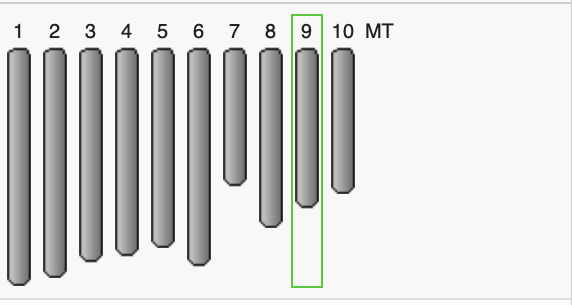It is my understanding that the Type 4 Chemotype cultivars have both THCa and CBDa synthase “turned off” enabling the plants to bioaccumulate CBGa the precursor to all cannabinoids. Luckily we have a resident expert on the subject @seth that can chime in and correct anything I may have wrong ![]() Credit : Oregon CBD Farmers Resources I Oregon CBD I The Trusted Source for Feminized Hemp Seed
Credit : Oregon CBD Farmers Resources I Oregon CBD I The Trusted Source for Feminized Hemp Seed
The Detailed Answer
Figure 1. Whole Sequence Cannabis Genome Browser

When THC production genes are turned “on” and CBD is turned “off,” plants are THC dominant, psychoactive, and are considered type I (recreational and medical). When both CBD and THC genes are turned “on,” plants are moderately psychoactive (as CBD lessens the psychoactivity of THC) and are considered type II (medical). When CBD production genes are turned “on” and THC is “off,” plants are considered type III (industrial hemp). When both THC and CBD production genes are “off,” plants only bioaccumulate CBG and are considered type IV (also industrial hemp). When upstream cannabinoid production precursor genes are turned off, no cannabinoids are produced (only terpenes), and the resulting plants are considered type V (“cannabinoid free,” also industrial hemp).
Figure 2. Cannabis Chemotype Typology
 Even with the THC genes “off,” type III and IV plants still produce a small amount of THC; the reason for this was unknown until we discovered the answer in early 2019. After tens of thousands of chemical and genetic tests (including whole genome sequencing of hundreds of plants), we now know that THC accumulation in type III and type IV varieties is due to CBCA genes, located on chromosome nine (remember: CBD and THC genes are located on chromosome six).
Even with the THC genes “off,” type III and IV plants still produce a small amount of THC; the reason for this was unknown until we discovered the answer in early 2019. After tens of thousands of chemical and genetic tests (including whole genome sequencing of hundreds of plants), we now know that THC accumulation in type III and type IV varieties is due to CBCA genes, located on chromosome nine (remember: CBD and THC genes are located on chromosome six).
Figure 3. Cannabis Chromosomes

The CBCA synthase primarily produces trace amounts of CBCa, but, because of its 99% DNA sequence identity to the THCA synthase, it also produces similarly low levels of THCa. The latest research on these genes indicates that small variations in CBCA alleles (specifically, single nucleotide polymorphisms or SNPs) affect their conversion efficiency of the cannabinoid precursor CBGa to either CBCa or THCa. Additionally, the total copy number of CBCA gene loci play a critical role in determining final THC concentrations as well; after sequencing hundreds of type III plants, we have found that all have between 6-8 copies of the active allele and this number is directly related to ratio inheritance (and therefore total THC potential). This is not unique to our plant collection; rather, it is the case for all commercially available type III varieties. The ramifications of this finding should become the death-knell of the scientifically invalid 0.3% THC limit.
In our high cannabinoid hemp research programs, we have encountered plants that range from .05%-1% THC by dry weight on trimmed flowers. This means the federal limit of 0.3% is socially constructed rather than scientifically accurate (unless only leaves are tested!), but we must currently abide by this mandate, which makes sampling protocols and test-timing critical. High cannabinoid hemp farming is still possible (as evidenced by the explosion of this industry), but seed selection is also paramount for success. Farmers must consider a seed variety’s CBD:THC and/or CBG:THC ratio, total cannabinoid content, and appropriate sample timing in their state to achieve good results, as all three of these variables play critical roles in successfully growing a full-term crop of legal, industrial hemp.